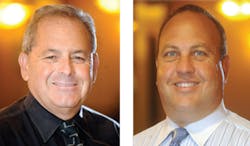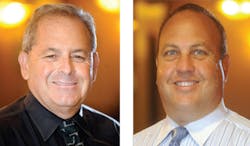Interview with Drs. Richard Steinberg and Daniel Delrose
by Dr. David Gane
DR. GANE: We are now well on our way to a preferred future where a new generation of digital imaging technologies has emerged with promises to expand our capabilities and redefine our business models. Business-minded dental professionals are migrating to a virtual world where treatment planning, restorative design, and fabrication take place chairside in a single appointment.
While attending the launch of Carestream's new intraoral scanner and chairside milling system at the IDS in Cologne, Germany, I had the opportunity to discuss CAD/CAM dentistry with two very early adopters of this technology -- Drs. Richard Steinberg and Dan Delrose from Ellenton, Fla.
DR. GANE: When did you start using CAD/CAM dentistry?
DRS. STEINBERG & DELROSE: We have been creating chairside restorations in our practice since 2002. Our initial motivation was to generate excitement in the office while keeping our technology and patient services cutting edge, interesting, and up to date. Optical impressions, restoration designs, and chairside milling quickly became an obvious time saver for our patients and us, and provided a very valuable service.
DR. GANE: Was there a learning curve when you introduced this technology?
DRS. STEINBERG & DELROSE: With the early systems, implementation was quite a challenge and took many restorations to finally attain the comfort level we were looking for. Today the systems have improved greatly, making it much easier to implement and mainstream the technology right out of the box.
DR. GANE: What were some of the early challenges that you had to overcome?
DRS. STEINBERG & DELROSE: Once the team realized that the technology actually worked as designed, it was a matter of going through multiple steps to get the desired restoration. The automating of many of these small but important steps made the design and creation of restorations immeasurably easier. Once the systems were in place and accepted by the team, we were able to give our patients better treatment.
DR. GANE: What types of restorations do you design and create chairside?
DRS. STEINBERG & DELROSE: We currently design crowns, onlays, and veneers. We predominantly use ceramic materials for their esthetic qualities, surface finish, and long-term durability, and among them are excellent products by Vident and 3M ESPE. We also use some resin blocks for inlays and are just starting to use more of the new resin-infused porcelains from VITA.
DR. GANE: How did your patients receive this new technology?
DRS. STEINBERG & DELROSE: Our patients were eager and happy to embrace this technology. They especially liked the single-visit approach and not having to endure traditional impressions. They told many of their friends and family about the "new" dentistry that we were doing in our office. This was an added dimension to our already outstanding customer service.
DR. GANE: Did you adjust your fee for this new service?
DRS. STEINBERG & DELROSE: We did not adjust our fees for chairside restorations. From an economic perspective, we save on the fabrication costs of the restoration, and also the additional time and resources required for setting up and breaking down the treatment room for a seat appointment. We also eliminate the loose or sometimes lost provisional restoration and the disruption to the office and patient that can cause. We have saved money, and we have saved the patients' time, which is money to them.
DR. GANE: How many indirect restorations do you need to provide in a month to get a return on your investment?
DRS. STEINBERG & DELROSE: We calculate the break-even point on the investment to be from nine to 20 restorations per month depending on price and financing package. There is also the added indirect benefit of a great internal marketing tool. CAD/CAM technology sets us apart from others in the area and allows us to become the office on the leading edge of technology. This is a great source of new business for us.
DR. GANE: CAD/CAM has been in dental practice for a long time, and has continued to improve. Where do you see the technology moving?
DRS. STEINBERG & DELROSE: The lost-wax technique will be gone eventually. There will be no more metal finishers, and patients will come to expect their crowns at the first appointment. The software will continue to become easier to use, and the optical scanners will be faster and more efficient and truer in color. More restorative material choices will become available, including a new generation of materials designed specifically for chairside milling.
DR. GANE:How is the overall quality and fit of a chairside restoration?
DRS. STEINBERG & DELROSE: To this day we’re still amazed how an in-office milled CAD/CAM restoration fits so much better than that of an experienced dental tech working off of a stone model.
DR. GANE: What are the main things to look for when buying a CAD/CAM system?
DRS. STEINBERG & DELROSE: The No. 1 consideration should be ease of use by the dentist, and more importantly by team members. It is very difficult to roll a "trolley" from operatory to operatory, and having to replace a broken wheel is not uncommon. If an intraoral scanner can be as portable and mobile as an intraoral camera, there will be no barrier among staff to using this technology. When they see the look and fit of the final restoration, it becomes a no-brainer. All of this is available with no messy impressions, no stone models, no remakes, and no occlusal adjustments.
DR. GANE: What would you say to your colleagues who are on the fence when it comes to chairside restorations?
DRS. STEINBERG & DELROSE: This is the FUTURE! CAD/CAM restorations are now the mainstay for dental laboratories because they know the success of CAD/CAM restorations. The next logical step for the dentist is to have this in-house. But for us non-computer-geek dentists, it has to do with having a simple workflow while delivering a quality restoration and satisfying restorative experience for the patient.
DANIEL C. DELROSE, DDS, is in private practice in Ellenton,Fla. He is the past president of the Academy of CAD/CAM Dentistry (AACD). You may reach him at [email protected].
RICHARD W. STEINBERG, DDS, FACCD, is the current president of the Academy of CAD/CAM Dentistry. He received his DDS from Emory University School of Dentistry in 1976 and practices general dentistry in Ellenton, Fla., where he is codirector and co-owner of North River Dental Group.
Past DE Issues

